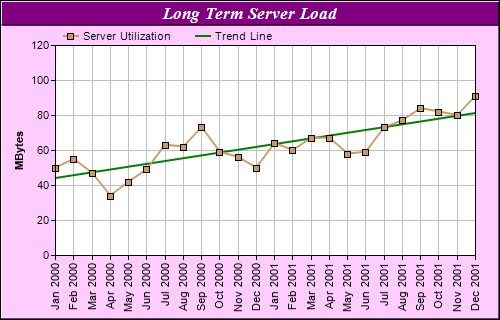
This example demonstrates linear regression trend line fitting. It also demonstrates rotating the x-axis labels by 90 degrees to save axis space.
A trend line is a straight line that best fit certain data points. A trend line is computed using linear regression (the least square method).
In ChartDirector, trend lines are created by using
XYChart.addTrendLayer or
XYChart.addTrendLayer2. A trend layer only shows the trend line, not the data points. Another layer, such as a line or scatter layer, can be used to show the data points.
In this example, two layers are used. A line layer displays the data points as symbols and draws a line that joins them. A trend layer draws a trend line that best fit the same data points.
Note that the x-axis labels are rotated by 90 degrees to save space. This is achieved by using
TextBox.setFontAngle of the
TextBox object that represents the x-axis label prototype.
The following is the command line version of the code in "cppdemo/trendline". The MFC version of the code is in "mfcdemo/mfcdemo". The Qt Widgets version of the code is in "qtdemo/qtdemo". The QML/Qt Quick version of the code is in "qmldemo/qmldemo".
#include "chartdir.h"
int main(int argc, char *argv[])
{
// The data for the line chart
double data[] = {50, 55, 47, 34, 42, 49, 63, 62, 73, 59, 56, 50, 64, 60, 67, 67, 58, 59, 73, 77,
84, 82, 80, 91};
const int data_size = (int)(sizeof(data)/sizeof(*data));
// The labels for the line chart
const char* labels[] = {"Jan 2000", "Feb 2000", "Mar 2000", "Apr 2000", "May 2000", "Jun 2000",
"Jul 2000", "Aug 2000", "Sep 2000", "Oct 2000", "Nov 2000", "Dec 2000", "Jan 2001",
"Feb 2001", "Mar 2001", "Apr 2001", "May 2001", "Jun 2001", "Jul 2001", "Aug 2001",
"Sep 2001", "Oct 2001", "Nov 2001", "Dec 2001"};
const int labels_size = (int)(sizeof(labels)/sizeof(*labels));
// Create a XYChart object of size 500 x 320 pixels, with a pale purpule (0xffccff) background,
// a black border, and 1 pixel 3D border effect.
XYChart* c = new XYChart(500, 320, 0xffccff, 0x000000, 1);
// Set the plotarea at (55, 45) and of size 420 x 210 pixels, with white background. Turn on
// both horizontal and vertical grid lines with light grey color (0xc0c0c0)
c->setPlotArea(55, 45, 420, 210, 0xffffff, -1, -1, 0xc0c0c0, -1);
// Add a legend box at (55, 25) (top of the chart) with horizontal layout. Use 8pt Arial font.
// Set the background and border color to Transparent.
c->addLegend(55, 22, false, "", 8)->setBackground(Chart::Transparent);
// Add a title box to the chart using 13pt Times Bold Italic font. The text is white (0xffffff)
// on a purple (0x800080) background, with a 1 pixel 3D border.
c->addTitle("Long Term Server Load", "Times New Roman Bold Italic", 13, 0xffffff
)->setBackground(0x800080, -1, 1);
// Add a title to the y axis
c->yAxis()->setTitle("MBytes");
// Set the labels on the x axis. Rotate the font by 90 degrees.
c->xAxis()->setLabels(StringArray(labels, labels_size))->setFontAngle(90);
// Add a line layer to the chart
LineLayer* lineLayer = c->addLineLayer();
// Add the data to the line layer using light brown color (0xcc9966) with a 7 pixel square
// symbol
lineLayer->addDataSet(DoubleArray(data, data_size), 0xcc9966, "Server Utilization"
)->setDataSymbol(Chart::SquareSymbol, 7);
// Set the line width to 2 pixels
lineLayer->setLineWidth(2);
// Add a trend line layer using the same data with a dark green (0x008000) color. Set the line
// width to 2 pixels
c->addTrendLayer(DoubleArray(data, data_size), 0x008000, "Trend Line")->setLineWidth(2);
// Output the chart
c->makeChart("trendline.png");
//free up resources
delete c;
return 0;
}
© 2023 Advanced Software Engineering Limited. All rights reserved.
